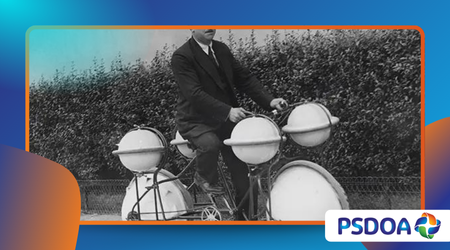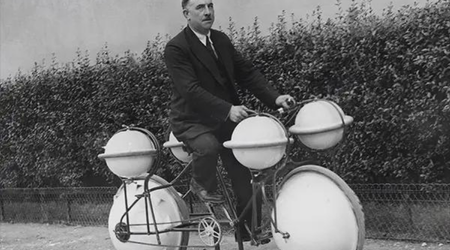The Cyclomer: A Bicycle That Could Float on Water

In the vibrant tapestry of human ingenuity, the Cyclomer stands as a curious thread, weaving together ambition and whimsy.
Anúncios
Unveiled in Paris in 1932, this amphibious bicycle promised to glide over land and water, a bold vision of versatile transport. Its massive, hollow wheels doubled as buoyant floats, allowing it to transition from cobblestone streets to serene rivers with ease.
Today, as we marvel at modern innovations like e-bikes and hoverboards, the Cyclomer invites us to reflect on forgotten dreams that dared to blur the boundaries between terrains.
Why did this invention fade into obscurity despite its daring promise? Let’s dive into its story, exploring its origins, mechanics, cultural impact, and lessons for today’s innovators, all while uncovering what this peculiar machine reveals about the human spirit.
The Cyclomer wasn’t just a bicycle; it was a statement of possibility. In an era of rapid industrialization, inventors pushed limits, dreaming of machines that defied nature’s constraints.
Anúncios
This amphibious marvel captured imaginations at a Paris exposition, where its creator demonstrated its ability to cross a swimming pool.
Its story resonates in 2025, as we grapple with sustainable transport solutions and climate adaptability. By revisiting the Cyclomer, we uncover not just a quirky relic but a lesson in bold experimentation and the fleeting nature of innovation.
The Birth of an Amphibious Dream
Picture Paris in 1932, a city buzzing with art, culture, and invention. Amid this creative fervor, a French engineer unveiled the Cyclomer, a bicycle designed to conquer both land and water.
Its hollow, orb-like wheels, resembling oversized beach balls, provided buoyancy, while a sturdy metal frame ensured durability. The inventor’s vision was simple yet audacious: why limit a bicycle to roads when rivers and lakes beckon?
This wasn’t the first attempt at amphibious transport. Earlier designs, like David Farmer’s 1869 Land & Water Velocipede, used buoyant wheels but lacked practicality.
++ Why We Stopped Using Zeppelins for Travel
The Cyclomer improved on these, with stabilizing floats that folded down for water travel, addressing the instability of two-wheeled designs on fluid surfaces.
Its demonstration at the Paris exposition, where it carried 120 pounds across a pool, proved its functionality, sparking excitement among spectators.
Yet, the Cyclomer emerged in a world unprepared for its quirks. Economic turmoil from the Great Depression limited funding for such novelties, and its complex design deterred mass production.
Still, its debut marked a moment of fearless creativity, a reminder that innovation often begins with a single, daring idea.

Mechanics Behind the Magic
How does a bicycle float? The Cyclomer’s genius lay in its engineering. Its large, hollow wheels, made of lightweight metal, doubled as flotation devices.
When on water, four stabilizing floats extended, ensuring balance. The rider pedaled as on land, with the wheels’ rotation propelling the bike forward, albeit slowly, through the water’s resistance.
This design wasn’t flawless. The wheels’ size made land travel cumbersome, and water propulsion was inefficient compared to boats.
A 1932 report in Scientific American noted the Cyclomer’s water speed averaged 1.12 m/s, far slower than contemporary bicycles on roads.
Also read: The Great Fireproof Cities Plan That Never Happened
Still, its ability to transition without mechanical changes was revolutionary, a precursor to modern amphibious vehicles.
The Cyclomer’s mechanics highlight a key lesson: innovation often sacrifices efficiency for versatility. Its clunky design didn’t deter its creator, who saw potential where others saw limitations.
Today, engineers designing multi-terrain drones or urban mobility solutions can draw inspiration from this balance of ambition and compromise.
Cultural Impact and Public Reception
The Cyclomer wasn’t just a machine; it was a spectacle. At the Paris exposition, crowds gathered, awestruck, as it glided across water.
Newspapers hailed it as a glimpse into a future where transport knew no boundaries. Yet, public enthusiasm waned as practicality concerns emerged. Could it truly replace boats or bicycles?
In the 1930s, society craved solutions to economic and social woes, not whimsical experiments. The Cyclomer became a curiosity, featured in magazines but rarely in garages.
Its cultural legacy, however, endures in its bold challenge to convention, inspiring later inventors to rethink mobility. Imagine a world where such a device caught on would we have amphibious bike lanes today?
Read more: Tesla’s Earthquake Machine: Real Invention or Urban Legend?
This fleeting fame mirrors modern trends. In 2025, viral inventions like AI-powered skateboards often capture attention but struggle to sustain it.
The Cyclomer teaches us that public reception hinges on timing and utility, not just novelty. Its story asks: what makes an invention timeless?
Lessons for Modern Innovators
The Cyclomer’s tale offers a blueprint for today’s creators. First, it underscores the value of bold ideas. Its inventor didn’t ask if a floating bicycle was practical but whether it was possible.
This mindset drives breakthroughs, from electric cars to vertical farming. Second, it highlights the importance of context.
The Cyclomer faltered amid economic constraints, a reminder that even brilliant ideas need the right environment to thrive.
Consider modern parallels. In 2025, urban flooding from climate change has spurred interest in amphibious transport.
A startup in Amsterdam recently prototyped an electric amphibious scooter, echoing the Cyclomer’s vision.
Data from the European Transport Agency shows 15% of urban commuters seek multi-terrain solutions, a niche the Cyclomer might have filled. Its failure wasn’t in design but in timing.
Finally, the Cyclomer reminds us to embrace failure. Not every invention changes the world, but each fuels progress. Innovators today, from biotech to green tech, can learn from its fearless experimentation, pushing boundaries even when success isn’t guaranteed.
The Cyclomer’s Legacy in 2025
Fast-forward to 2025, and the Cyclomer feels oddly relevant. As cities adapt to rising sea levels, amphibious vehicles are no longer just novelties.
Engineers draw inspiration from past designs, including the Cyclomer, to create flood-resistant transport.
Its hollow-wheel concept influenced modern amphibious trikes, like those tested by Southampton University students in 2008, which achieved seamless land-water transitions.
Beyond engineering, the Cyclomer’s legacy lies in its spirit. It embodies the audacity to dream big, even if the world isn’t ready.
In an era of AI-driven innovation, this human-centric approach feels refreshing. The Cyclomer wasn’t perfect, but it was a spark, igniting ideas that ripple through time.
Consider a modern analogy: the Cyclomer is like a rough draft of a novel, flawed but brimming with potential.
Its ideas, like characters, evolve in later works, shaping the narrative of progress. Today’s innovators, from sustainable transport to space exploration, owe a nod to such early dreamers.
Why the Cyclomer Matters Today
The Cyclomer’s story isn’t just a historical footnote; it’s a call to action. In 2025, as we face climate challenges, its vision of versatile transport resonates.
Cities like Miami and Jakarta, prone to flooding, need solutions that blend land and water mobility. The Cyclomer’s concept could inspire modular vehicles adaptable to urban floods.
Moreover, its failure teaches resilience. Not every idea succeeds, but each contributes to the mosaic of progress.
The Cyclomer’s bold design, though impractical, pushed boundaries, much like today’s experimental hyperloop projects. Its legacy asks: what bold ideas are we dismissing too quickly?
Finally, the Cyclomer celebrates human curiosity. In a world dominated by algorithms, its quirky charm reminds us that innovation begins with imagination.
As we pedal toward a sustainable future, let’s honor the Cyclomer’s spirit by daring to dream beyond the horizon.
| Aspect | Details |
|---|---|
| Invention Year | 1932, unveiled in Paris |
| Key Feature | Hollow wheels for buoyancy, stabilizing floats for water travel |
| Max Load | 120 pounds |
| Water Speed | 1.12 m/s (Scientific American, 1932) |
| Cultural Impact | Brief fame at Paris exposition, faded due to economic and practical issues |
| Modern Relevance | Inspires amphibious vehicle designs for flood-prone urban areas |
Conclusion
The Cyclomer, a fleeting star in the 1932 Paris sky, remains a testament to human daring. Its hollow wheels and buoyant dreams didn’t conquer the world, but they left ripples.
In 2025, as we navigate climate challenges and urban evolution, its story urges us to embrace bold ideas, even if they falter.
From its splashy debut to its quiet fade, the Cyclomer teaches us that innovation isn’t just about success it’s about courage.
As we design the future, let’s pedal forward with the same audacity, asking: what boundaries can we break next? The Cyclomer’s legacy lives not in museums but in the spark it ignites in dreamers today.
Frequently Asked Questions
Q: What was the Cyclomer’s main purpose?
A: The Cyclomer aimed to provide seamless travel on land and water, combining bicycle mobility with amphibious functionality for versatile transport.
Q: Why didn’t the Cyclomer become popular?
A: Economic constraints of the Great Depression, impractical design, and limited infrastructure for amphibious travel hindered its widespread adoption.
Q: Are there modern equivalents to the Cyclomer?
A: Yes, modern amphibious trikes and scooters, like those tested in 2008 by Southampton University, draw inspiration from the Cyclomer’s design.
Q: How fast could the Cyclomer travel on water?
A: It averaged 1.12 m/s on water, as reported by Scientific American in 1932, slower than typical bicycles on land.
Q: Can the Cyclomer’s concept be applied today?
A: Absolutely. Its ideas inspire flood-resistant transport solutions for cities facing rising sea levels, like modular amphibious vehicles.
References:
